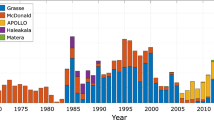Abstract
A transportable lunar laser ranging station can be expected to measure the range to the lunar corner retroreflectors from a site on the Earth's surface with an uncertainty of about 3 cms. The accuracy with which that station can infer its geocentric position is influenced by many factors including the uncertainties in the pole position and rotation rate of the Earth and the data loss due to weather.
The results of a simplified modelling study intended to include these factors are presented in cartographic form. The modelling indicates that, assuming the successful operation of three or more widely separated fixed laser stations, the transportable station will be able to determine its relative geocentric position in all three coordinates with an accuracy comparable to the original range uncertainty.
Similar content being viewed by others
References
O. CALAME: Première détermination d'une longue base terrestre par télémétrie laser-Lune et localisation du réflecteur de Lunakhod I.,C. R. Acad. Sc. Paris, Série B, 280, 551, 1975.
J.P. HAUSER: An analysis of the effects of systematic errors in the lunar ranging experiment, Ph.D. thesis, University of Colorado, Boulder, 1974.
W.M. KAULA: Potentialities of lunar laser ranging for measuring tectonic motions,Philos. Trans. Roy. Soc. London, A274, 185, 1973.
G.L. LOUMOS, J.D. MULHOLLAND, P.J. SHELUS, and E.C. SILVERBERG: Accuracy of site coordinates obtainable by a mobile lunar laser station: final report, Univ. of Texas Research Mem. in Astron. #75-007, Austin, 1975.
I.I. MUELLER, F.A. FAJEMEROKUN and H.B. PAPO: The influence of laser ranging on selenodetic control, paper presented at COSPAR, Madrid, May, 1972, inCOSPAR Space Research XIII, 1015–1022, Akademie-Verlag, Berlin, 1973.
A. STOLZ, P.L. BENDER, J.E. FALLER, E.C. SILVERBERG, J.D. MULHOLLAND, P.J. SHELUS, J.G. WILLIAMS, W.E. CARTER, D.G. CURRIE and W.M. KAULA: Earth rotation measured by lunar laser ranging,Science, 193, 997, 1976.
A. STOLZ and D. LARDEN: Accuracy obtainable for Universal time and polar motion during the EROLD campaign, paper presented at the Symposium on Scientific Applications of Lunar Laser Ranging, Austin, 9 June, 1976.
J.G. WILLIAMS: Geodetic results from lunar laser ranging,EOS (Trans. Am. Geophys. Union)56, 236, 1975, (abstract).
Author information
Authors and Affiliations
Rights and permissions
About this article
Cite this article
Silverberg, E.C., Shelus, P.J., Mulholland, J.D. et al. An estimate of the geodetic accuracy attainable with a transportable lunar laser station. Bull. Geodesique 50, 331–340 (1976). https://doi.org/10.1007/BF02521586
Received:
Revised:
Issue Date:
DOI: https://doi.org/10.1007/BF02521586



